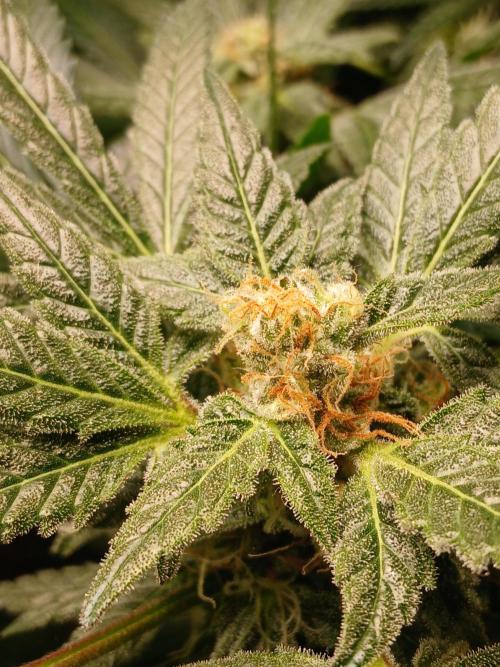The Grow Awards 2026 🏆 






















required lightning
just4funm23started grow question 2y ago
What is the required amount of lightning in a 100x100x180 tent for 1-2 plants with a pretty decent yield? how can I calculate it for myself?
Solved
Other. General questions
Setup. Lighting
likes
Incognitusanswered grow question 2y ago
Area is what matters and number of plants does not. Number of plants will impact how much vege time you need to fill the area, but not requirements of light for that area.
Your hours of operation matters. So, whether you grow photoperiods or not will have a big impact on what you need.
Based on 12hours per day, you are capped at about 800-900PPFD... this is an upper 30's DLI range (daily light integral). Your daily light integral allows an apples to apples comparison of energy applied to the plant regardless of area or hours of operation. Simply put, 35-40DLI will have the same results over 12 hours as 18 hours, ceteris paribus. Read the wiki. Get the gist. It's important to understand the causality here to avoid the nonsense you'll read and hear over the years.
Efficacy of grow lights varies, so using watts per square foot has inherent pitfalls and inconsistencies. Stick to DLI. It's a better, smaller ballpark to start in. Shoot for 35-40DLI and then observe and react to plant to fine tune power and hanging distance -- hanging distance should be more about geometry of your coverage, but is an available tool to impact light intensity at canopy, too. All suggestions will requires some trial and error, and using DLI will be the least amount of trial and error to get to a good point.
Luckily, witha 100x100 area, that's just 1 meter-square, so you don't even need to do any math for PPFD. The umol/s of you rlight will be the PPFD if hung a proper distance to focus the light in the most even way across your 100x100 canopy. So any light that puts out 800-900 umol/s (per your 1m^2) is your PPFD. Then, reference that with hours of operations with a DLI table that you can easily google.
how efficacy can significantly impact this... takes 2.3umol/J vs 2.8umol/J
900 / 2.8 = about 320 watts with a high efficacy light can produce 900PPFD in your 1m^2 tent context
900 / 2.3 = about 390 watts needed...
if you look up old HID lighting and the 50w/sq ft suggestion that was fairly consistent because of regulations in making a bulb. Whether due to some shady lobbyist group of the industry or not, the consistency allowed for the use of watts per sq foot and it worked well... it does not anymore. Some lights are drastically more efficient at producing light than others. A 70-watt difference can be seen in the example above and that's just for a small 1m^2 area.
.07kw x 12 x 60 + (.66 * .07) *18 * 40 = 83.664 kW-H extra for a 40day vege on 18h cycle and a 60 day bloom on 12 hour cycle... That's only a 17 USD difference in 1 grow cycle around here. YMMV based on local cost of electricity. An area 4x as big that's a 60 USD difference every grow cycle... 4x a year... it can add up. over 10 years of use you'll spend 600 more on the less efficient light. you can see why spending a 100 more at point of sale is worth it for a high quality light.
This topic is only debatable if you don't actually know the details... it can seem complicated, but it is not. Local variables will make for different "max" DLI... temps, humidity and more importantly atmospheric CO2 will dictate how much your plants can handle... not your choice in lights, though it should match the variables.
My sugestion is easily converted for an autoflower grower ... adjust inverse proportionally to hours of operations. 18 - 12 is simply 12/18 or 67% over 18hours comes out to the same DLI. So, 600PPFD is about all you need for autoflowers in a 1m^2 tentn with 18hour cycle. (2/3rds of 900PPFD above)
Turns out education is quite useful daily.
SimpleGrowanswered grow question 2y ago
In principal cannabis can take alot of light and the yield grows linear with the light intesity. But only IF the rest of your environment is spot on. If you want big yield you‘ll need alot of light and for that you must have a proper nutrien solution wich doesn‘t burn the plant from all the respiration. You‘ll need a fluffy media wich doesn‘t flush the plant while watering. In Generall you can go as high as 1000 ppfd but at some point you‘ll need CO2 enrichment. Also you‘ll have high temperatures with alot of light so u‘ll have to make sure u get it down. This is a long answer but if you want big yield you should go for arounf 1000 ppfd in flower (600-800 ppfd in Veg). I‘m saying this because most people get huge lights but the rest of the setup is lacking! If you have a race car and you want to go full speed, you‘ll have to make sure everything is perfect for that.
1 like
Complain
AutoflowersSucKanswered grow question 2y ago
Optimal back in the days of HID lights it was 50 watts per square foot. If you look up the ppfd conversion of what that was, that will give you a base to go with. From there i'm sure you can determine the perfect LED
1 like
Complain
HeavyHittahanswered grow question 2y ago
Fem plants you want around 450 to 500watts in 1m(LED) . The bar lights make an even spread.
Autos you can get away with 300watts in a 1 meter.
That's considering you want to max out your tent .
If you are only doing a couple of plants 400 watts would do.
Mars hydro and Spider farmer make good lights at reasonable prices .
HLG if you can afford .
I opted for AC Infinity.
1 like
Complain
TheUk420Showanswered grow question 2y ago
this is a very debateable topic personally i find the bigger the better if you want good yields you need good lights a powerful ones in small enviroments its not the best for the heat though. I would say a a telos slim is a great light for that size tent there are so many on the market mars hydro lights can be good for value though its a personal choice or whatever you can get ffor cheap lol i have a 600 watt led but in a 4ft x 4ft though alot of people are going with the zues light atm looks to be a nice light but there are just so many options lol best of luck buddy
1 like
Complain
YorkshireGardenerukanswered grow question 2y ago
https://youtu.be/d4aElpuHkhI?si=QUWibMd3-Nhz3JzF
All ways a good start have a look at some he knows done all the hard work all ready for you
1 like
Complain
Similar Grow Questions
Solved

BalconyWiTCH
(PHONE CLOSE UP PICS)
is it time to harvest?
PIC 1TO5 Green gelato
PIC 6 TO 10 Hulkberry
PIC 11 TO 15 Royal gorilla
I´m quite disappointed with the focus, but hope this helps hahaha.
Other. Harvest - Drying
Other. General questions
5y ago
3
3
Solved

Nurse
help mi guys. yellow leavesThe heads of the leaves turn yellow and then their burn.I only fertilized twice.For a few weeks, I only use city water, 500 ppm.And water Run off 1000 ppm.should i do to give more water to reduce ppm?And what should be the ppm of run off?Or should I fertilizer later? thanks
Other. General questions
Feeding. Other
5y ago
2
3
Solved

facingbacktofront
How short of a time frame into Veg can one go without added nutrients.Soil is 3 parts Roots organic og,1 part FFOF,1 part perlite, light bat guano, and microbes to the rootzone. I have calmag that I'll be adding to my feed but nothing else until I grab the nutrients I decide on. Safe to say I can go this short time (2 days) without added nutrients?Week 1
Other. General questions
6y ago
2
2
Solved

Papi62034
When do I transplant?When should I transplant this to its permanent home?
Other. General questions
5y ago
1
2
Solved

Kadash368
Green Poison ready to harvest?Hello. What do you think, are we ready to harvest? 7 weeks in flowering Green Poison Fast Version. Thank you for your opinion
Other. Harvest - Smoking
Other. General questions
18d ago
2
2
Solved

Nacho64r
RangosAlguien me puede explicar cómo funciona los rangos y los ascensos de los mismos, o un link donde lo explique, no lo veo por ningún lado
Other. General questions
2y ago
6
4
Solved

idkwhatimdoing
LED light recommendation?so going by my last question, i need a growlight. so i wanted to ask if theres a budget light for like 2 plants. i dont have a ton of space n im kinda lost on the topic. i live in europe so itd be great if it was a light i could get in my country too. germany's fine as well.Setup. Lighting
3y ago
2
2
Solved

DWCbuds
Lights airstone c02What light to plant distance would you set it at? The only test I've done is at 25 inches its stable at 80°f and 75% humidity. When I lower it to 18 inches, the tent read 85°f and 73 humidity.
Other question I have is what's your favorite air stone(disk)?
Lastly, add c02 yes/no
5y ago
2
2
Solved

Breakupp
Leave stem is dark purple!!Hi one of the 3 plant (same strain) leave stem is very purple looking. Is this due to deficiency? There was strong winds few days ago, can this be stress? Current ph is at 6.2 in soiless medium. Should I increase ph for mag to absorb easier? Please advise and thank you in advance
Week 9
Other. General questions
5y ago
2
2
Solved

BullWeedDog
Entrada de luz a mi carpa de cultivo del exterior Puedo esto alterar el foto periodo?he colocado mi carpa de cultivo al lado de una ventana, me he metido adentro y he cerrado la carpa y me di cuenta que por la entrada del extractor he intractor entra como un reflejo de la luz no pega luz directa y en realidad se ve oscuro completamente dentro, puede ser problema?Other. General questions
Setup. Strains - Photoperiod
4y ago
1
1
Solved

sticky_ickyy
How long left for this plant?How long do you reckon the mimosa has left?
On schedule to finish in a week and a half.
Thank you!! 😀Week 15
Other. General questions
5y ago
2
2
Solved

GrowCN
Lighting HorsepowerI have a Horticultural Lighting Group 260 QB V2 R Spec light (260 watt LED). I previously had a 20" x 36" tent and the light was great. I have just gotten a 36" (91cm) x 36" (91cm) tent and wondering if this is enough power for great production or if more light would be better?Setup. Lighting
5y ago
5
Solved

NuntaBulyu
Help needed with diagnosisHas anyone encountered this problem before, can you please tell me what these black spots are ?
Is it Fungus, Mold or something else ?
It has only just started on one of my outdoor Seedlings and I have never had this before should I be worried.
Other. Mold
Other. General questions
Plant. Other
5y ago
2
2
Solved

Kershaw1231
Is my plant healthyIs my plant healthy?
She seems to be growing a bit slow I don't know if thishe is normal I have started her on nutrients today we are going into the 3rd week of being in the pot
this is my first grow and I'm stuck I'm doing her in the cupboard as no room for tent
Other. General questions
Other. Other
Plant. Other
5y ago
1
2














